
When erected in 1820 to the design of Cdr. Samuel Brown RN, a pioneer in chain making, this was the longest wrought iron suspension bridge in the world.
Chain Bridge, Horncliffe, Berwick on Tweed TD15 2XT
The Union Chain Bridge (also known locally as Union Bridge) is a suspended-deck suspension bridge that spans the River Tweed between Horncliffe, Northumberland, and Fishwick in Scotland. When it opened in 1820 it was the longest wrought iron suspension bridge in the world with a span of 133 m (437 ft), and the first vehicular carrying bridge of its type in the United Kingdom. Although work started on the Menai Suspension Bridge first, Union Bridge was completed earlier. Today it is the world's oldest suspension bridge still carrying road traffic. (See also entry for Gattonside Suspension Bridge).
The bridge was maintained by the Tweed Bridges Trust, between the abolition of turnpike tolls in 1883 and 1986 when Tweed Bridges Trust was wound up. It is now managed by Northumberland County Council in an arrangement struck between the two local authorities. Part of it lies in the Scottish Borders Council area, formerly the County of Berwickshire, and is therefore listed at category A as well as Grade 1 listed building. Generally works that affect the whole bridge will require two consents.
Its longevity may owe something to the fact that it was designed by a Royal Navy officer, Captain Samuel Brown. Brown's first design for the bridge was prepared in 1817, and reviewed by the eminent civil engineer John Rennie. Brown had built at his London works an experimental suspension bridge with a span of 110 ft, which impressed Rennie. Nonetheless, Rennie asked for changes to the design of the stone abutments and towers.
Brown would have been familiar with the fact that a wooden sailing ship is not totally rigid and designed the bridge on the same basis. Originally the deck was supported by six chains of iron bar links on each side. In 1903 a pair of wire rope cables was added. The decking is of timber and flexibility is an innate feature of this type of construction.
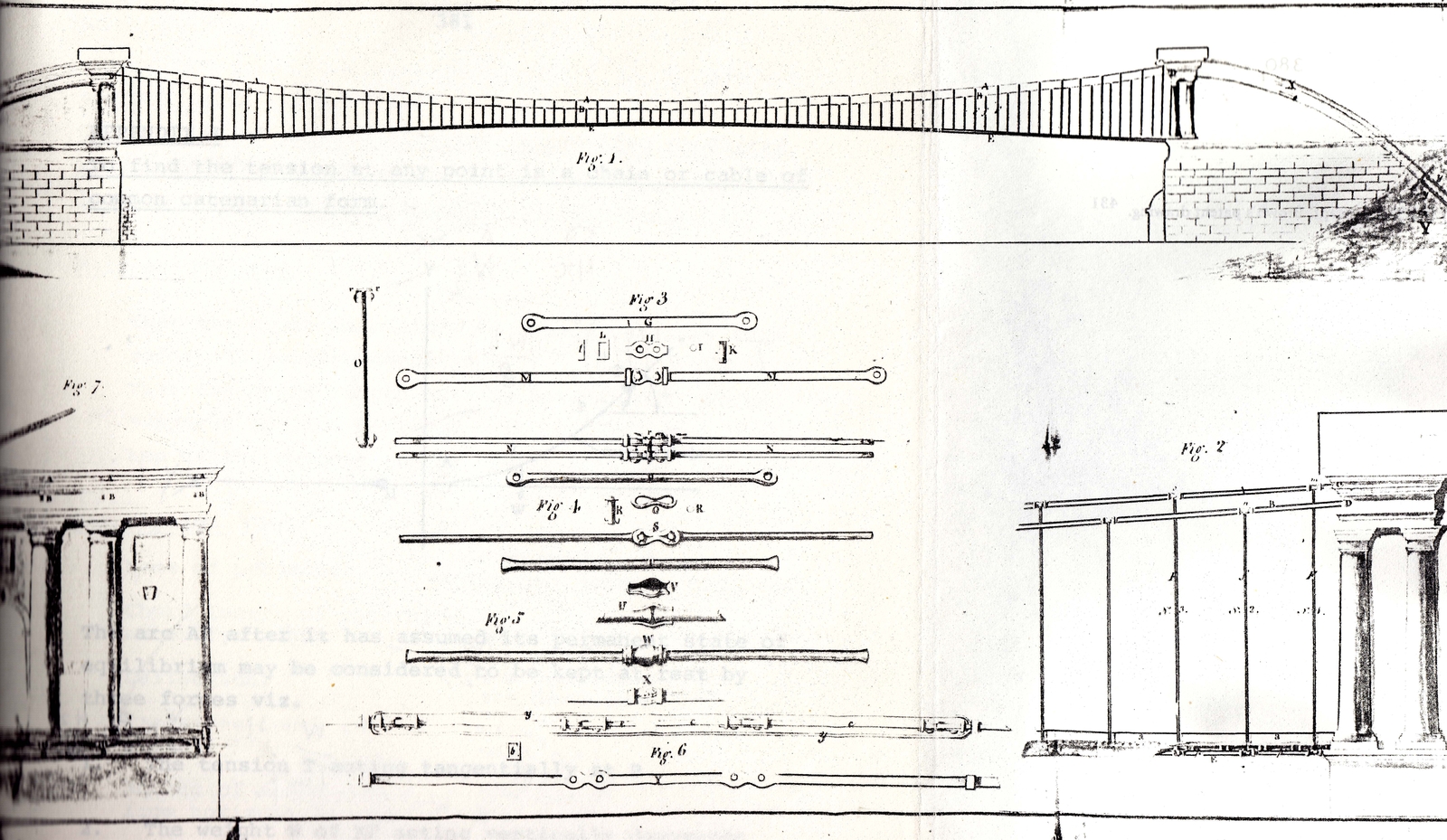
Union Bridge Browns patent 1818
The bridge proposal, received consent in July 1819 using an Act of Parliament that had been passed in 1802, and construction began 2 August 1819. It opened on 26 July the following year, with an opening ceremony attended by Robert Stevenson among others. Captain Brown tested the bridge in a curricle or tandem followed by a number of loaded carts, before a crowd of about 700 spectators crossed. The final cost was about £7,700.

In addition to the 1903 addition of cables, the bridge has been strengthened and refurbishment on many occasions. The bridge deck was substantially renewed in 1871, and again in 1974. It lies on Sustrans Route 1 and the Pennine Cycleway.
In September 2019 the National Lottery Heritage Fund announced a grant of £3.14 million for crucial repair works which started in early 2020, completed and reopened to traffic in 2023.
The Institution of Civil Engineers presented a plaque commemorating the significance of the bridge in 2020 which was unveiled on 6th July 2023
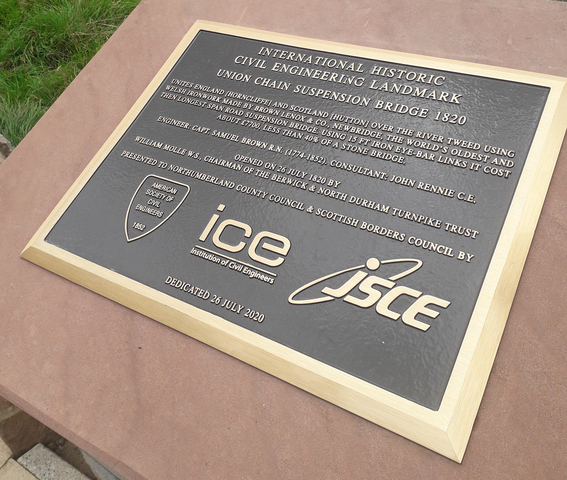
Above text has been corrected following feedback from Simon Rudman BEng (Hons) CEng MIStructE, Design Manager, Highways & Transport, Northumberland County Council - with thanks.
The Friends of Union Chain Bridge's series of newsletters provided an update on the repair work and are available for download here:
April 2023 newsletter - restoration completed
December 2023 Christmas Newsletter
This entry has contributions from Prof. Roland Paxton, Mark Watson, Edward Cawthorn and The Friends of the Union Chain Bridge, Simon Rudman, Jerry Swift and John Yellowlees for which the National Transport Trust expresses its thanks.
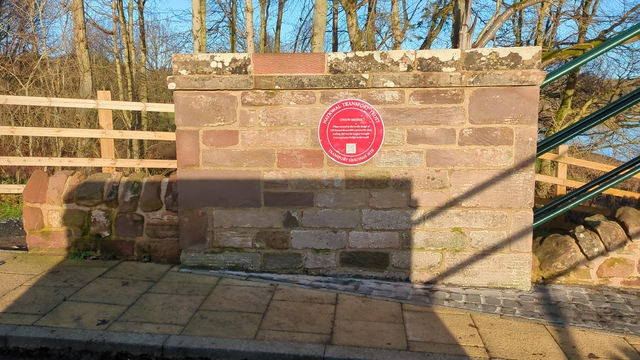
The NTT Red Wheel Heritage Plaque was erected in January 2024 on the downstream Scottish pillar.
It was unveiled on 8 March 2024 is a small ceremony by John Home Robertson, the former MP for the area, whose family home is Paxton House, a short distance downstream. One of John's forbears part funded the Union Bridge.
John Home Robertson said:
Thanks to the National Transport Trust for this recognition of the great significance of our Chain Bridge - as the first suspension bridge that was ever constructed to carry wheeled traffic.
And thanks for inviting me to do the honours, not so much as a former local MP, but also as a family successor to George Home of Paxton, who attended the meeting at the Hen & Chickens Inn in Berwick in 1818 to consider the selection of Captain Sam Brown's revolutionary design for this wrought iron suspension bridge.
George Home subscribed £200 towards the cost of the bridge in 1820. That was 4% of the total cost of £5k. I'll just say that I'm relieved that I was not expected to pay for 4% of the £10m cost of its recent restoration.
In 1820, the Old Bridge spanned the Tweed down at Berwick, and there was a newer stone bridge upstream at Coldstream. But the developing farms in eastern Berwickshire needed a lot of lime and coal from kilns and pits on the English side, and their horsedrawn carts had to use a very hazardous ford across this big tidal river. Often, the ford was impassible. And there is no easy site for a high-cost stone arch bridge.
But the landowners had the good fortune to know a local Royal Navy Captain who had ideas about the potential of chains to support a bridge from above. And Captain Sam Brown happened to have an interest in a chain manufacturer in Pontypridd, in Wales. This was the nineteenth century equivalent of rocket science, but it was less expensive than masonry, so they gambled on Captain Brown's high-tech solution. It flew, and as you can see, it is still flying over the Tweed today. Built to carry lime and coal to local farms, it now stands as the pioneer for ever-bigger suspension bridges all over the world - from the Brooklyn bridge in New York to the Akashi bridge in Japan and the bridges over the Bosphorus. Our Chain Bridge is the forerunner of them all.
We could have lost it. Because it now only carries light local traffic, it was difficult for our local Councils to justify the heavy cost of major restoration after 200 years. So we set up the Friends of the Union Chain Bridge in 2013 to campaign to save the bridge, with the benefit of Prof Roland Paxton as our patron, and vital assiduous attention to every detail by Ted Cawthorn, our secretary.
Crucially, we received immediate support from Councillor Grant Davey, then the Leader of Northumberland County Council, and a similar commitment from Councillor Michael Cook on Scottish Borders Council. Then came essential backing from the National Heritage Lottery Fund and other heritage agencies and charities. As tends to happen, the estimated cost escalated from £5m to £10m. But we got there. While I'm mentioning names, I'll add that Spencers the engineering contractors and their workforce have impressed and made a lot of local friends during their time here.
This bridge is an internationally important milestone in the history of civil engineering for transport. So it is absolutely right that it is being awarded Red Wheel recognition. We want people to come and see this masterpiece. With that in mind, can I fire a quiet warning shot at Scottish Borders Council : here we are at the one and only Red Wheel Site in all of the seven counties in the south of Scotland, but look at the state of the Scottish end of the bridge - a shocking access road; nowhere to park; and inadequate signage and interpretation. Please get your fingers out!
Leaving that aside for the moment, I'm very grateful to the National Transport Trust for this important recognition, and very happy to unveil this Red Wheel on this wonderfully restored Father of All Suspension Bridges.
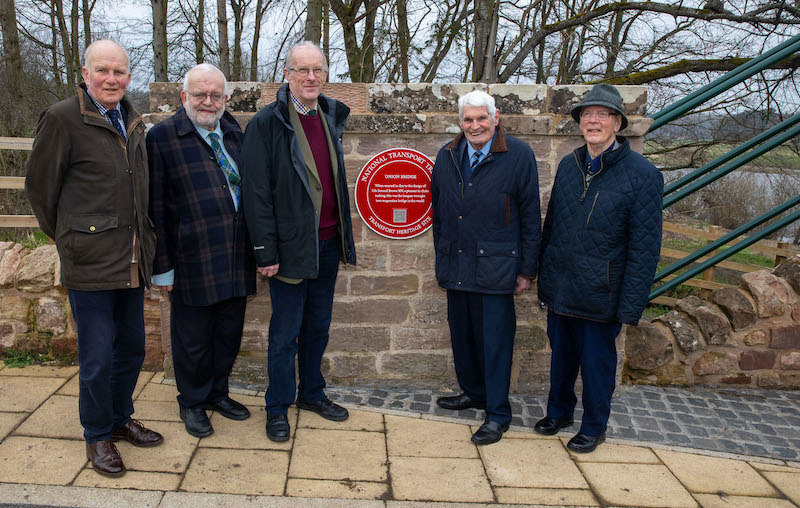
Edward Cawthorn (Friends of Union Bridge), John Yellowlees (NTT), John Home Robertson, John Cameron (NTT), Professor Roland Paxton
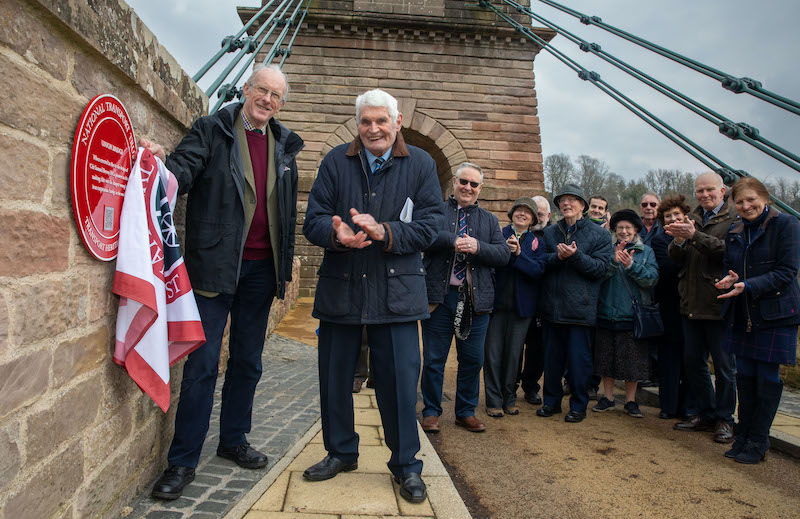
Professor Roland Paxton provided this article on the opening of The Union Chain Bridge
By road: Off A698 at Horncliffe, west of Berwick on Tweed.
Direct navigation links:
what3words address: ///golden.farms.midfield
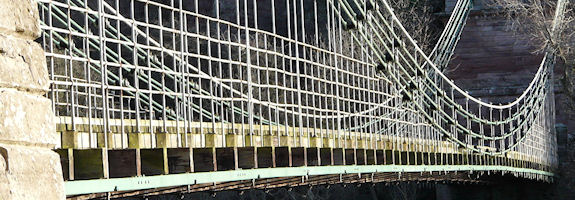
Drewry, C.S., A Memoir of Suspension Bridges: Comprising a History of their Origin, BiblioBazaar, ISBN -10 05547 25657 (2008)
Melan, Josef, Theory of Arches and Suspension Bridges (1913, Kessinger Publishing, ISBN-10: 1437437125 (2008)
Paxton, R. and Ruddock, T., A Heritage of Bridges Between Edinburgh, Kelso and Berwick , Institution of Civil Engineers, Edinburgh and East of Scotland Association, ASIN: B001OPGJZ0, (1980)
Peters, Tom, Transitions in Engineering: Guillaume Henri Dufour and the Early 19th Century Cable Suspension Bridges, Birkhauser, ISBN-10: 3764319291 (1987)
Steinman, David, A Practical Treatise on Suspension Bridges: Their Design, Construction and Erection (1922), Kessinger Publishing, ISBN-10: 1436606446 (2008)
Steinman, David, Suspension Bridges and Cantilevers, BiblioBazaar, ISBN-10: 0559673132 (2008)
Miller, Gordon and Jones, Stephen K. Samuel Brown and Union Chain Bridge, ISBN 978 1 5272 1616 7 (Berwick upon Tweed 2017)